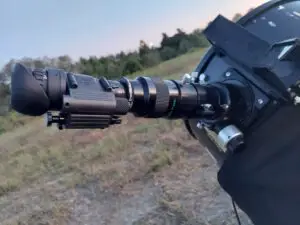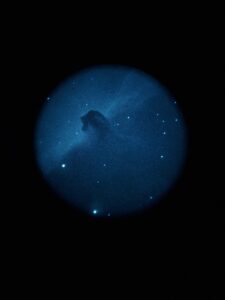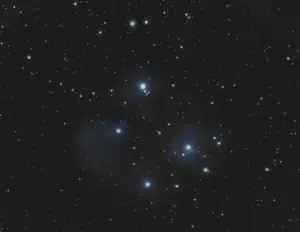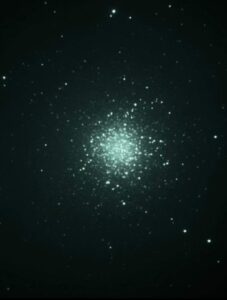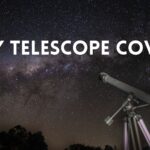Saturn, the jewel of the solar system. Every amateur astronomer remembers their first view of the ringed planet, and for good reason. Nothing quite prepares you for just how much it looks like Saturn.
I’ve had more than one person accuse me, half-seriously, of putting a Saturn slide in my telescope. If you have a telescope, viewing Saturn should be high on your to-do list.

This was my first view of Saturn. 240x magnification, using a 10mm plossl and 2x barlow lens in an 8-inch Dobsonian.
When you are shopping for eyepieces remember that magnification is telescope focal length divided by eyepiece focal length.
Planets are small targets. To see them in detail, sufficient magnification is required.
Which is the best eyepiece for viewing Saturn?
How much magnification is enough?
What other considerations should be taken into account?
In this article, we’ll try to answer these questions as well as clear up some misconceptions when it comes to magnification.
What Focal Length Should You Buy?
This goes back to the question about magnification, which is determined by your telescope focal length divided by eyepiece focal length: a 1000mm telescope will deliver 100x magnification with a 10mm eyepiece and 50x with a 20mm eyepiece.
If you can only afford one eyepiece for planets, I would recommend something which delivers around 75% of your telescope’s maximum useful magnification.
A better solution is to aim for 40-50% of maximum magnification and add a 2x barlow lens, which will allow you to crank up the power on those rare nights of superb seeing.
Your telescope’s maximum usable magnification should be published in the user manual. If not, assume it is 50x per inch of aperture. Higher magnification will likely lead to soft, dim images.
What is the best eyepiece for viewing Saturn?
In short, the best eyepiece for viewing Saturn will be one which maximizes the magnification potential of both your telescope and your local seeing conditions.
The eyepieces should also provide a wide enough angle for extended viewing, and comfortable eye relief.
How you achieve this will depend on what sort of telescope you have, your eyepiece budget, and a few other factors which we will explore in more detail.
How Much Magnification Do You Need to See the Rings of Saturn?
You don’t need a ton of magnification to detect Saturn’s rings. 30x should be enough to tell you are looking at Saturn, but the view will probably not blow you away at this power.
In fact, the rings might look more like ears sprouting from the side of the planet. Indeed, this was what Galileo saw when he aimed his prototype telescope at Saturn.

To see the rings clearly, 50-75x is where you want to start.
If you are hoping to see detailed features, such as the Cassini Division or the rings’ shadow on the planet, aim for 120x or more.
Note that these are not exact figures; your visual acuity, sky conditions, and telescope aperture will all influence how much you can see at a given magnification.
On a night of steady seeing, an 8-inch reflector can produce sharp views over 300x. In a smaller telescope, or from a less-than-ideal observing location, Saturn might appear blurry and unfocused at even half that magnification.
For planetary viewing, it is a good idea to have an assortment of magnifications available so you can select the best one for the conditions on a particular night.
We recommend that you keep a small eyepiece collection and a barlow, you do not need to go crazy collecting eyepieces, but have what you need.

What to look for in an eyepiece for Viewing Saturn?
Apparent Field of View
Saturn itself doesn’t require a large apparent field, as it is a small target and will easily fit in the field of any eyepiece.
However, if you are using a manually-driven telescope, such as a Celestron Astromaster or a Dobsonian reflector, a wider field of view will allow you to view Saturn for longer before needing to recenter your target.
Anything over 60 degrees is a good start; I preferred an 82-degree apparent field.
Eye Relief
If you wear glasses while observing, eye relief of at least 15mm should be high on your list of priorities, particularly if your telescope is manually-driven.
Eye relief is somewhat less critical if your telescope has tracking, but even without glasses, having long eye relief allows for more comfortable viewing, and longer viewing sessions.
Lens coatings, edge blackening
Eyepiece quality varies quite wildly, which in turn affects the quality of the views.
For viewing bright objects like Saturn, you want an eyepiece which will have good color correction and control over internal reflections. Good coatings and edge blackening will help in this regard, but a lot of it comes down to quality control and cost.
Better-quality eyepieces usually, but not always, have features such as fully multicoated (FMC) optics, blackened barrels and blackened lens edges for maximum contrast and control over lens flares and ghosting.
A low-grade eyepiece is more likely to suffer from reflections than one of higher quality.
Eyecup
An often-overlooked feature, a fold-down or twist-up eyecup offers a lot of value, particularly if you can set the eyecup to a desired height. This ensures you can take full advantage of the available eye relief and apparent field, while also helping to control blackouts caused by misalignment of your pupil.
Good-quality eyepieces use soft rubber which is comfortable against your face while preventing stray light from entering the eyepiece.
Recommendations
There is a lot to consider, but just remember you are looking for high magnification with a wide field of view and comfortable eye relief.
Now let’s look at some specific suggestions for different eyepiece models.
Plossl
This is the standard-issue eyepiece included with many mid-grade telescopes. You probably already own a plossl or two.
Plossls can provide sharp views with good contrast, but field of view and eye relief are generally on the small side, especially at shorter focal lengths.
Most suitable for non-eyeglass wearers, and people with tracking mounts.
The 7.5mm Orion Serius Plossl is a good example of an eyepiece for viewing Saturn. This has very little eye relief and a small field of view.
Orthoscopic
These specialized eyepieces are known as “planet killers” due to high contrast and sharpness. The good ones such as Brandon and University Optics are quite rare and expensive.
Field of view is even smaller than plossl, so best suited for tracking mounts.
This Baader Planetarium eyepiece is a good choice in a mid price range. If you can find it the 6mm or 8mm would be great choices as well.
Planetary eyepieces
The obvious choice, these are sold under a variety of brands such as Orion Edge-On, Celestron X-Cel LX, William Optics SPL, and TMB Planetary. They offer moderately wide fields with generous eye relief and sharpness to the edge of the field, and can be had for a reasonable price.
At the higher end of the scale, Pentax XL and Tele Vue Delite offer top-notch comfort and performance at a premium price.
The Orion Edge-On 6mm or the 9mm are great mid range choices here and this is what I would recommend to most beginners. The eye relief will make viewing more comfortable although its field of view is on the smaller side.
Ultra-Wide Eyepieces
For users with manually-driven mounts, these eyepieces with apparent fields over 70 degrees give you the most viewing time before having to re-center the planet, allowing you to relax and see more detail. This also makes it easier to increase the magnification without losing your target.
The best ones give performance to rival any planet-killer: Nagler Type 6, Pentax XW, and Baader Morpheus are just three examples that are worth checking out. On a smaller budget, Meade, Celestron, Orion, and other companies sell comparable eyepieces which will please most users.
Cheaper models may be affected by internal reflections, ghosting, or lateral color, so be sure to read some reviews first.
The Orion LHD Lanthanum is a good budget eyepiece that will give you an enormous field of view. Here I linked the 6mm, but the 9mm, 4mm or 7mm will all be good low power choices.
Zoom Eyepieces
These all-in-one oculars provide a variable range of focal lengths by twisting the eyepiece barrel, allowing you to change magnification on the spot.
Budget and premium models are available, with variable focal lengths from 8-24mm providing a wide range of magnifications.
Celestron and Orion are popular, while Baader Planetarium is the gold standard. For extra-high power, the Nagler Zoom is worth considering.
General Tips for Viewing Saturn
- Put your telescope outside for at least 30 minutes before observing, so it can reach ambient temperature.
- Avoid viewing over rooftops or buildings.
- Ensure your telescope is collimated, if applicable.
- Don’t get discouraged if the view seems wavy, like viewing underwater. Some of my best views have come on nights of poor seeing; you can hit pockets of steady air even on crummy nights, so have patience!

